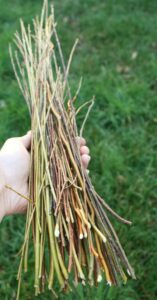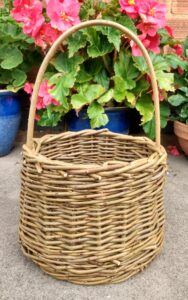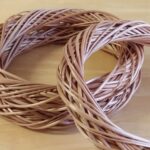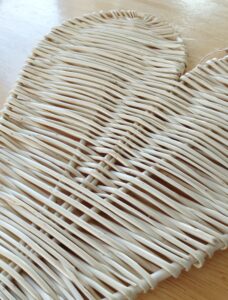Preparing willow for your project
There are many varieties of willow, over 400 I believe! I mostly weave with Black Maul, Whissender, Dicky Meadows, and Flanders Red varieties but I mix it up according to what I’m making…
Here is a little introduction to willow from my perspective as a weaver. I’ve focused on the few main types that I use in my work, and how to prepare them. I hope this gives you some insight or guidance. Happy weaving…
Green Willow
Green willow means freshly harvested willow. It does not refer to the colour but to it being freshly cut. It is very flexible to weave with and is great for beginners or anyone wanting to get straight into a willow project. It needs no soaking and can stay flexible for up to approximately 6 – 8 weeks after being cut, but do note that green rods will shrink in diameter as they dry out.
Brown Willow
Brown willow is willow that has been dried with the bark left on. It is regularly used in basketry work and again, brown is not referring to the colour of the rod.
To prepare dried willow for weaving it needs to be submerged in cold water and left to soak. The general rule is that you soak the rods for one day per foot, so for instance 3 foot rods will need 3 days, 5 foot rods will need 5 days, and so on. Once soaked the rods should be wrapped in a damp (not soaking) breathable cloth/towel to mellow overnight, then it should be pliable enough to weave with for your project.
* To note, some factors such as very cold temperatures, and certain willow varieties, may mean longer soaking times are needed.
Buff Willow
Buff willow is processed willow, in that the natural willow rod with its bark still on is boiled in water for a few hours. The bark softens and the process changes the colour of the rod underneath (That is how you get the lovely warm caramel ‘buff’ colour) and then the bark is removed (‘Stripped’…Another name for this willow) to leave the wonderfully smooth rod on show.
To prepare buff willow for weaving you need to submerge the rods in cold water and leave to soak. The general rule is that you soak the rods for 1.5-2 hours however do note your suppliers instructions as some recommend an hour of soaking per foot of rod length. In my experience if soaking anything up to 5ft lengths then 1.5-2 hours works well…
Once soaked the rods should be wrapped in a damp (not soaking) breathable cloth/towel to mellow overnight, then it should be pliable enough to weave with for your project.
White Willow
White willow is another processed willow… ‘Green’ willow that has been freshly cut in the winter (as explained above) is left to stand in water until the sap rises in the spring, and then the willow is stripped of its bark to reveal the beautiful white/off white colour rod underneath.
To prepare white willow for weaving you need to submerge the rods in cold water and leave to soak for approximately 1-1.5 hours. Once soaked the rods should be wrapped in a damp (not soaking) breathable cloth/towel to mellow for a few hours/overnight, then it should be pliable enough to weave with for your project.
I hope you have found this introductory information useful. Willow is a fantastic material to work with and can be pretty forgiving, particularly used green or semi green. Like any material, just having a go and practicing is great learning experience. Have fun!
Some Frequently Asked Questions
Q. Where is the willow you use grown?
A. I currently purchase willow from growers in the UK, mostly from the Somerset levels from companies that grow and sell willow and related products…
Some useful links:
www.musgrovewillows.co.uk
www.willowgrowers.co.uk
www.englishwillowbaskets.co.uk
Q. Do I need to protect my sculpture that is going outdoors?
A. The sculptures I make are fully natural and are ‘ready to go’. Thus they can be installed as is, in your garden. The non-living willow I use is, essentially, sticks, and therefore will deteriorate over time. Your sculpture should last a good few years, but to prolong its life, you can apply a breathable wood preserve. Please read any safety instructions of any preserves carefully before use, and please ensure they are not detrimental to the environment! If like me you’d rather leave your willow item fully natural, you can bring your sculpture or item inside over the winter to keep it protected from bad weather to prolong it’s life.
Q. Can I place my willow heart/wreath/indoor decor anywhere in the home?
A. You can place your indoor decoration item where you like in the home, however please note that if placed in direct sunlight the wicker may fade in colour (to note particularly if your item is coloured/dyed willow). If placed in direct heat such as in a conservatory the willow may become brittle more quickly, as you would expect with any sticks dried out very quickly. In addition willow is a natural material so do not place it close to a lit fire! Also, prolonged damp conditions will reduce the life of the item. Remember that willow is a natural material and won’t last forever. Part of it’s natural rustic charm is it has been utilised for hundreds of years, that it will biodegrade in the end and is an environmentally friendly product.




